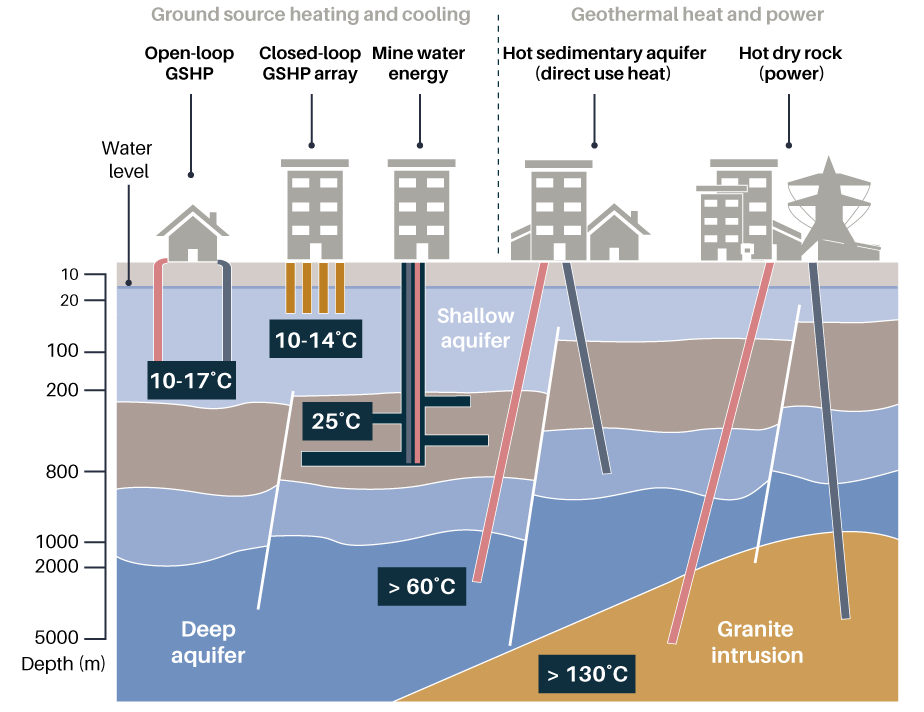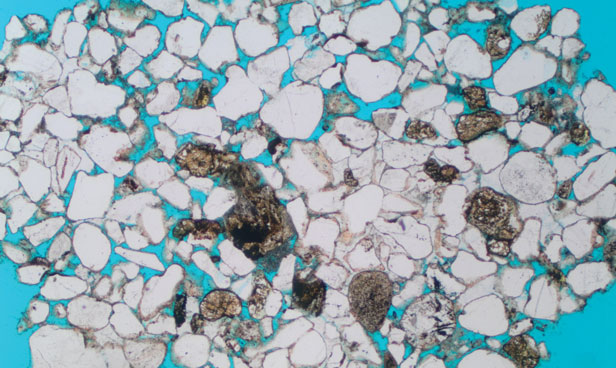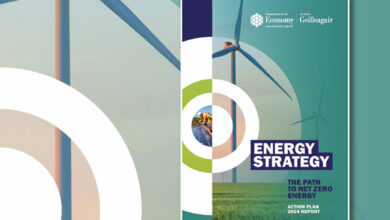Using science to produce clean heat, create jobs and warm homes

The UK is legally-bound to achieve net zero greenhouse gas (GHG) emissions by 2050. Northern Ireland generates 47.7 per cent of its electricity from renewable sources but the heat and transport sectors of the energy system still rely heavily on fossil fuels and are more challenging than the power sector to decarbonise.
Geothermal energy has the potential to form part of the solution through its direct use as a low carbon energy source and the role it can play in optimising the electrification of heating and cooling. The Geological Survey of Northern Ireland (GSNI) is actively researching the geothermal potential of Northern Ireland.
Geothermal energy
Geothermal energy is heat derived from the ground from depths of a few metres to multiple kilometres beneath the Earth’s surface.
Low-grade heat stored in the shallow subsurface (<200m) is derived from solar radiation absorbed by the ground and distributed via natural groundwater systems or industrial structures such as flooded mines. This energy is widely described as ground-source energy or shallow geothermal energy. Higher temperature heat resources at depths of >500m are termed deep geothermal energy. In Northern Ireland this resource is most easily accessible in buried hot sedimentary aquifers.
The temperature of the Earth increases with depth, this is described as the geothermal gradient. This gradient is not uniform across the globe and in the UK is around 26°C/km (Busby, 2014). Assuming an average annual air temperature of 12°C, this means that subsurface temperatures at 1,000m, 3,000m and 5,000m are around 39°C, 89°C and 139°C, respectively.
Applications
Geothermal energy is a growing part of energy supply in many countries including France, Germany the Netherlands, Denmark and in some UK cities. Shallow Ground Source Heat Pump (GSHP) systems can be used for heating and cooling of individual buildings or, with larger multiple loop systems, for small-scale heat networks. GSHP systems are particularly useful in decarbonising heat in residential or commercial premises, especially for those not connected to the gas network.
In contrast, hot sedimentary aquifer geothermal systems have larger capacities and greater efficiencies and the heat can be used directly, or if hot enough, for power generation. Direct use of geothermal energy primarily includes space heating and cooling, district heating, swimming pools and spas, agriculture (mainly greenhouse heating or crop and timber drying), fish farming, and use with heat pumps (for both heating and cooling) in industries such as data centres.
Northern Ireland’s geothermal resources
During the oil crises of the 1970s, governments looked to geothermal to ensure security of supply. The presence of geothermal resources in Northern Ireland was proven in 1979 by an exploratory borehole when water with a temperature of 66°C was recorded at 1902m depth in the Sherwood Sandstone. These results led to the siting of the Larne No 2 geothermal borehole in which an equilibrated temperature of 91°C was calculated at 2880m depth.
Why use geothermal?
In 2020 the challenges include climate change, clean and inclusive growth following the Covid-19 virus, energy decarbonisation and job creation as part of a green new deal and helping 22 per cent of families living in fuel poverty and energy inefficient homes in Northern Ireland (NIHE, 2018).
In Northern Ireland, by 2022, approximately 560,000 of all homes (approx. 70 per cent) will have access to the gas network which in future could distribute green hydrogen, but low-carbon and sustainable solutions are also required for the remaining 30 per cent of homes.
Geothermal technologies are low carbon, do not depend on the weather, are unobtrusive, scalable, have long lifespans, can be retrofitted to homes and require minimal remediation costs.
Wells to extract groundwater have existed on this island for centuries and there are thousands of modern borewells across Northern Ireland servicing farms and businesses with sustainable fresh water today. Shallow geothermal heat from groundwater, using heat pumps replaces fossil fuels for heating and cooling and reduces the carbon footprint.
Geothermal energy use fits with six of the 17 UN Sustainable Development Goals and aligns with the Northern Ireland Programme for Government Outcome 2: We live and work sustainably – protecting the environment.
In Paris there are 53 geothermal plants in the Paris Basin providing hot water to almost 200,000 homes; one geothermal doublet (one well taking out hot water and another returning the cooler water) provides 70°C water from 1,800 m depth and runs a 12.2 MWth geothermal plant, saving €1.9 million and almost 17,000 tons of CO2 per year compared to gas. The geothermal doublet has a 35-year lifespan, which can be extended for an extra 35 years by re-casing the wells (Hofmeister and Baastrup Holm, 2014).
Northern Ireland’s geology is comparable to the Paris area and would suit similar geothermal installations; the 400–650 m thick Sherwood Sandstone is present at depths down to 2km and beneath this lie older sandstones also with good porosity and hotter temperatures. The inferred geothermal resource for waters hotter than 40°C in the Sherwood Sandstone alone is 35 EJ (exajoules) equivalent to 9.72 million GWh of energy (Busby, 2014).
Geothermal holds potential for green jobs and in Germany where there is a growing geothermal industry in addition to carbon savings, the utilisation of geothermal energy has created >22,000 jobs and provided an economic stimulus of €13.3 billion since 2000 (BMWi data). In 2019, across 25 European countries there were 5.5 GWth of installed capacity for geothermal district heating and cooling systems and two million ground source heat pumps (EGEC, 2019).
What are the barriers to geothermal?
Despite the potential, the uptake of geothermal resource within the UK remains low relative to other nations. Technical barriers (i.e. geology, engineering, flow rate and temperature) are not limiting uptake. Non-technical barriers include lack of risk insurance schemes and longer payback times owing to the relative value of hot water versus petroleum; however, this is changing with the need to decarbonise our energy mix.

It has been recognised (GTR-H 2006, CSA 2008) that potential commercial investment in the development of deep geothermal energy in Northern Ireland requires greater certainty on regulation, including clarification on the legal ownership of resources, licensing, planning and permitting regimes, and policy support mechanisms.

The Department for the Economy in Northern Ireland is currently developing a new Energy Strategy for Northern Ireland which will set the strategic direction for energy decarbonisation to 2050. The strategy will address a range of measures to decarbonise the energy sector through a ‘whole-systems’ approach. How we may make use of our geothermal resources to decarbonise our heat sector will be considered as part of this process.
Geothermal Conference
GSNI and the Queen’s University Belfast Centre for Sustainability, Equality and Climate Action (SECA) hosted an online conference on Friday 11 December to consider the potential for geothermal resources in Northern Ireland.
‘Building Back Better: A future for geothermal energy in Northern Ireland’ featured case studies from Europe and the UK and generate heat policy ideas that can feed in to the Energy Strategy for Northern Ireland and a cross-border, collaborative geoscience research project.
Dr Rob Raine
Energy Geologist, GSNI
Dundonald House, Belfast, BT4 3SB
E: Rob.Raine@economy-ni.gov.uk






